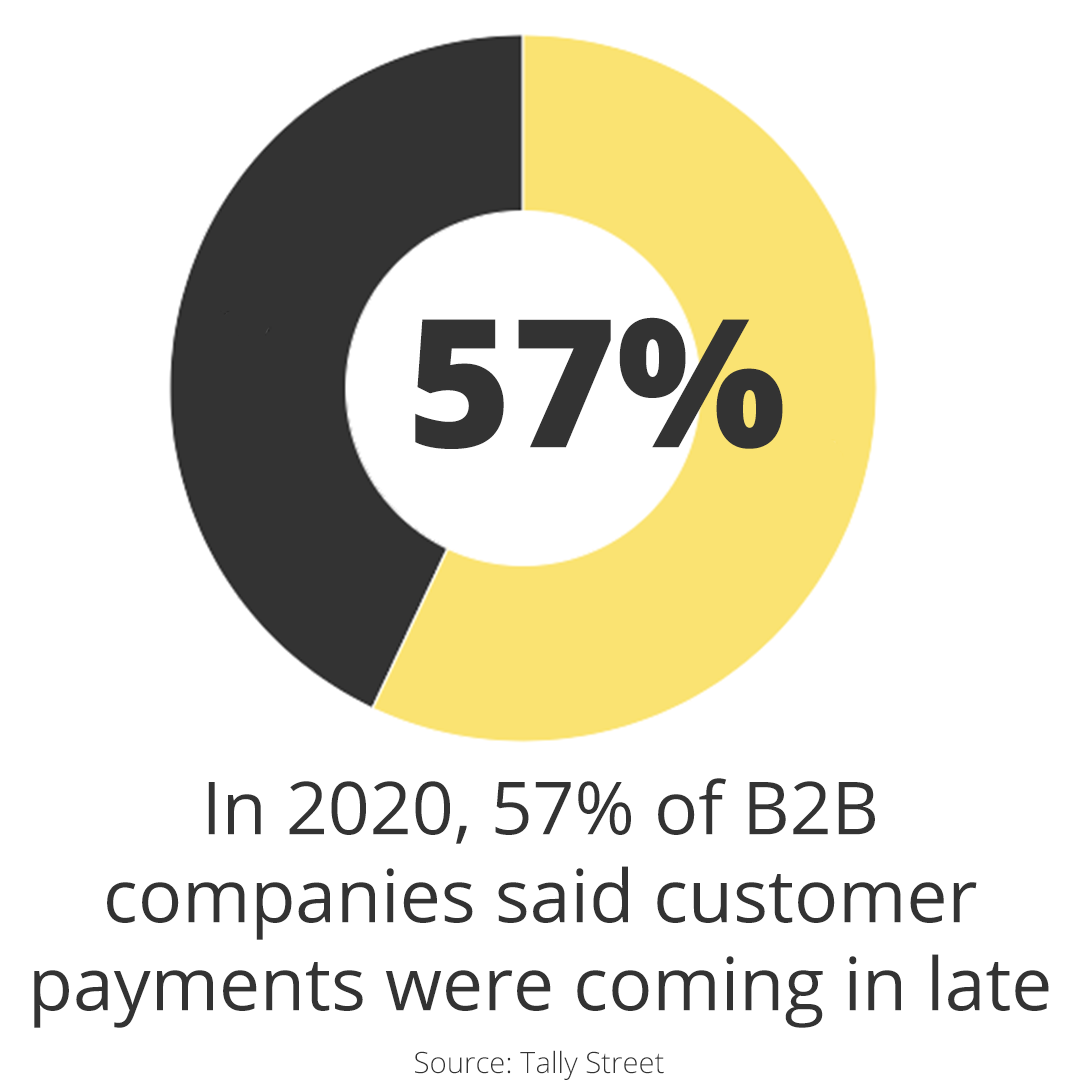Ready, Set, Stall: How Late Payments Slow B2B Business Growth

Having a lot of sales on the books is good; realizing the revenues associated with those sales quickly is even better for your business. Find out how late payments impact your ability to do business and learn how to calculate the opportunity costs associated with slow cash flow.
6 in 10 B2B companies say their customers pay late
 In 2020, 57% of B2B companies said their payments were coming in late (Tally Street), and it’s not a new phenomenon. For instance, the vast majority of US businesses – 90% – surveyed in an Atradius study reported that their company was impacted by late payments on customer invoices in 2018, and said that about half of their outstanding receivables were usually overdue.
In 2020, 57% of B2B companies said their payments were coming in late (Tally Street), and it’s not a new phenomenon. For instance, the vast majority of US businesses – 90% – surveyed in an Atradius study reported that their company was impacted by late payments on customer invoices in 2018, and said that about half of their outstanding receivables were usually overdue.
Seen individually, it might not seem like a late payment from one of your customers is a big deal. However, the negative impacts and associated costs your business experiences from late payments overall can be significant. In the Atradius study:
- 22% of B2B businesses impacted by late payments had to do something to correct cash flow
- 20% had to postpone payments to their suppliers and vendors
- Nearly one out of five lost revenue
If your business loses revenue due to late payments, you may be unable to take on new business as quickly, or you might have to say no when a large order comes your way. Especially if your business falls behind on payments to your vendors and suppliers. In addition, you won’t be able to take advantage of quick-pay or cash discounts your suppliers offer, which drives the cost of goods sold up, and you might have problems meeting payroll.
Calculating the cost of late payments for B2B companies
One of the ways to stay on top of outstanding accounts receivables is to know your numbers, such as the average value of overdue invoices, average days late, average days paid, and average days sales outstanding.
- Average Value of Overdue Invoices formula
To calculate your company’s average value of overdue invoices, divide the total dollar amount represented by all outstanding invoices by the total number of outstanding invoices.
Example – Value of Overdue Invoices
$350,000 = total monetary value of all outstanding invoices
#15 = number of individual outstanding customer invoices
350,000.00 ÷ 15 = $23,333.33
- Average Days Late formula
To calculate the average days late for your accounts receivable, divide the total number of days represented in outstanding invoices by the total number of outstanding invoices.
Example – Average Days Late
For this example, we’ll use 345 cumulative number of days late for the same 15 invoices, for an average of 23 days late for all overdue invoices.
345 ÷ 15 = 23 days late on average
To make this data even more meaningful, you could also use a formula which weights the severity of impact for large invoices more heavily than small invoices, such as sum (item amount * days late) / sum (item amount).
- Average Days Paid formula
Average Days Paid is simply the average number of days your customers take to pay any and all invoices, regardless of whether they are paid on time or late. It’s calculated just like Average Days Late, except that you take the cumulative number of days it takes for customers to pay invoices and divide that by the total number of invoices. This data can also be helpful in helping you determine whether adjusting customer terms could help reduce both average days late and average days paid in order to speed up business cash flow.
- Average Days Sales Outstanding formula
Days Sales Outstanding is an especially important number for B2B business owners and financial professionals to know. It tells you how fast your business is converting receivables into cash after making a sale. You can track this number over time to spot potential cash flow problems from customers’ late payments before they occur based on when this number increases.
To calculate Average Days Sales Outstanding (DSO), divide the total dollar amount of outstanding accounts receivable in a given period by the total dollar value of sales invoiced during the same time period, and multiply that by the number of days in the period (usually a month).
Example – Average DSO
$135,000.00 = Current outstanding receivables
$148,000.00 = Credit sales for the month
30 = Number of days in the month
135,000 ÷ 148,000 * 30 = 27.4 average days sales outstanding, or average number of days it takes to turnover receivables and receive payments.
The higher your DSO, the more strain on your business’ cash flow, and the more opportunity cost for your business. Opportunity cost is a common accounting term; it refers to any and all opportunities your business missed because it chose to do something else.
For instance, if you don’t take corrective actions or actions which can mitigate the impact of late payments (such as factoring invoices) then late payments and slow cash flow can hinder your ability to take advantage of supplier’s fast-pay or cash discounts. In this case, the opportunity cost is the dollar amount your business could have saved.
On the other hand, your business may also experience opportunity costs due to slow cash flow such as lost revenues if you have to wait to fulfill new orders or take on big orders. We have also previously discussed how slow cash flow can lead to layoffs or negative customer perceptions if your company doesn’t have adequate money to meet payroll expenses.
Invoice factoring mitigates the negative impacts of slow and late-paying customers
One reason Goodman Capital is one of the best invoice factoring companies is our breadth and depth of experience. This experience means we completely understand the importance of healthy cash flow and accounts receivable cycles for your business. Invoice factoring is one way your business can correct cash flow if late customer payments are stalling growth. When you factor invoices, you turn outstanding customer receivables into working capital, without waiting for your customers to pay.
Reach out to us for a free, no-obligation quote for invoice factoring services and find out how invoice factoring can speed up cash flow for your business.
